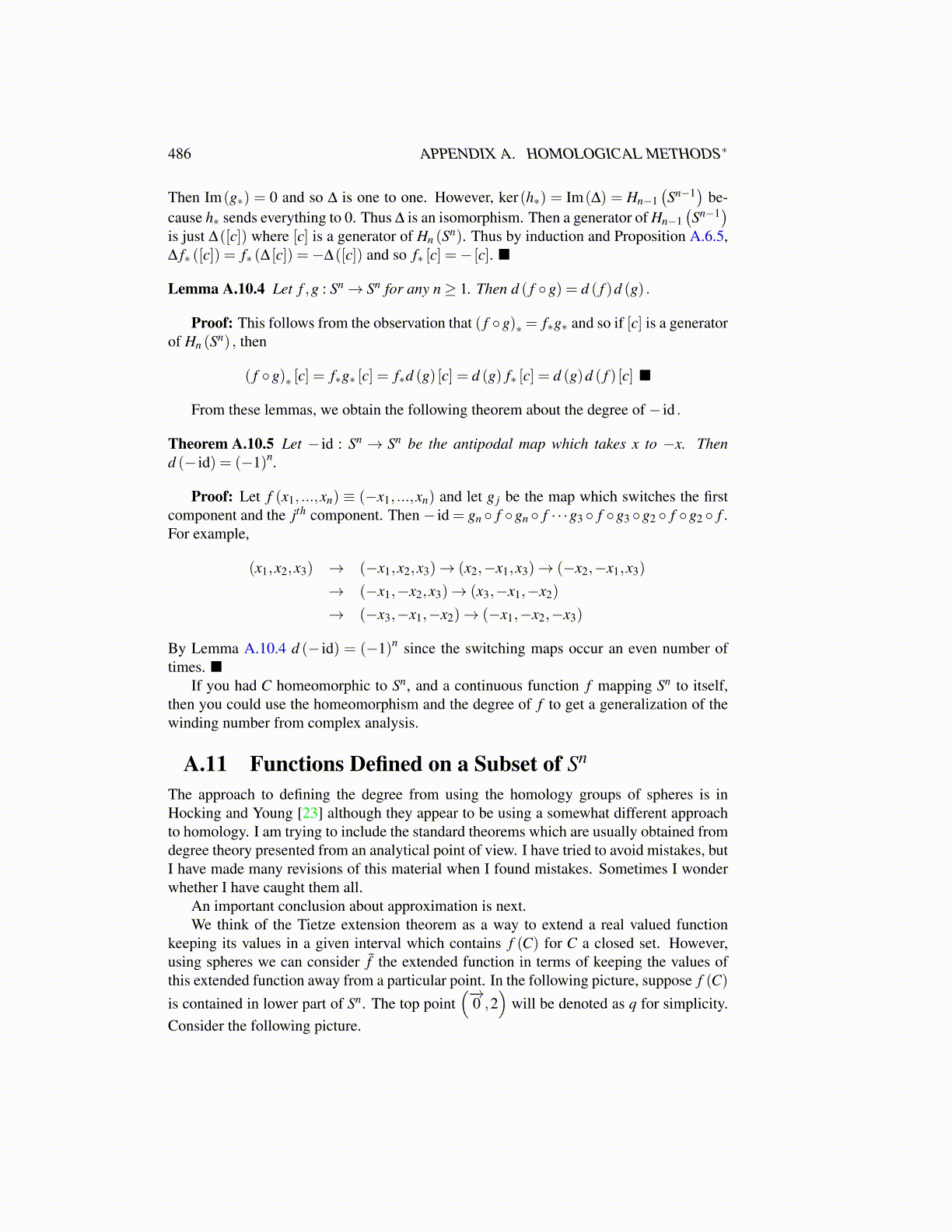
486 APPENDIX A. HOMOLOGICAL METHODS∗
Then Im(g∗) = 0 and so ∆ is one to one. However, ker(h∗) = Im(∆) = Hn−1(Sn−1
)be-
cause h∗ sends everything to 0. Thus ∆ is an isomorphism. Then a generator of Hn−1(Sn−1
)is just ∆([c]) where [c] is a generator of Hn (Sn). Thus by induction and Proposition A.6.5,∆ f∗ ([c]) = f∗ (∆ [c]) =−∆([c]) and so f∗ [c] =− [c]. ■
Lemma A.10.4 Let f ,g : Sn→ Sn for any n≥ 1. Then d ( f ◦g) = d ( f )d (g) .
Proof: This follows from the observation that ( f ◦g)∗ = f∗g∗ and so if [c] is a generatorof Hn (Sn) , then
( f ◦g)∗ [c] = f∗g∗ [c] = f∗d (g) [c] = d (g) f∗ [c] = d (g)d ( f ) [c] ■
From these lemmas, we obtain the following theorem about the degree of − id .
Theorem A.10.5 Let − id : Sn → Sn be the antipodal map which takes x to −x. Thend (− id) = (−1)n.
Proof: Let f (x1, ...,xn) ≡ (−x1, ...,xn) and let g j be the map which switches the firstcomponent and the jth component. Then − id = gn ◦ f ◦gn ◦ f · · ·g3 ◦ f ◦g3 ◦g2 ◦ f ◦g2 ◦ f .For example,
(x1,x2,x3) → (−x1,x2,x3)→ (x2,−x1,x3)→ (−x2,−x1,x3)
→ (−x1,−x2,x3)→ (x3,−x1,−x2)
→ (−x3,−x1,−x2)→ (−x1,−x2,−x3)
By Lemma A.10.4 d (− id) = (−1)n since the switching maps occur an even number oftimes. ■
If you had C homeomorphic to Sn, and a continuous function f mapping Sn to itself,then you could use the homeomorphism and the degree of f to get a generalization of thewinding number from complex analysis.
A.11 Functions Defined on a Subset of Sn
The approach to defining the degree from using the homology groups of spheres is inHocking and Young [23] although they appear to be using a somewhat different approachto homology. I am trying to include the standard theorems which are usually obtained fromdegree theory presented from an analytical point of view. I have tried to avoid mistakes, butI have made many revisions of this material when I found mistakes. Sometimes I wonderwhether I have caught them all.
An important conclusion about approximation is next.We think of the Tietze extension theorem as a way to extend a real valued function
keeping its values in a given interval which contains f (C) for C a closed set. However,using spheres we can consider f̄ the extended function in terms of keeping the values ofthis extended function away from a particular point. In the following picture, suppose f (C)
is contained in lower part of Sn. The top point(−→
0 ,2)
will be denoted as q for simplicity.Consider the following picture.